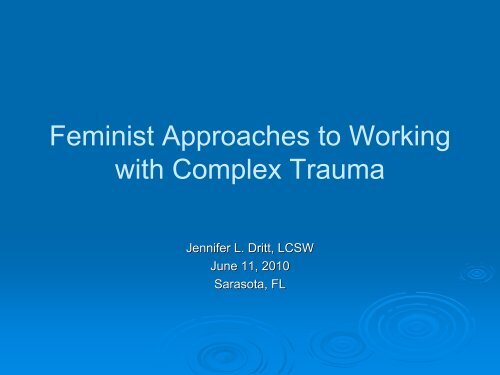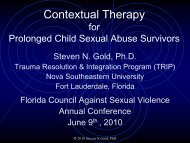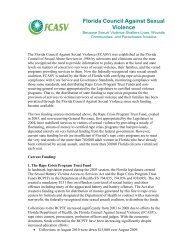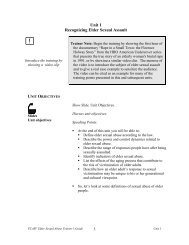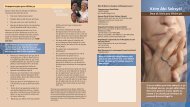Feminist Approaches to Working with Complex Trauma
Feminist Approaches to Working with Complex Trauma
Feminist Approaches to Working with Complex Trauma
- No tags were found...
You also want an ePaper? Increase the reach of your titles
YUMPU automatically turns print PDFs into web optimized ePapers that Google loves.
<strong>Feminist</strong> <strong>Approaches</strong> <strong>to</strong> <strong>Working</strong><strong>with</strong> <strong>Complex</strong> <strong>Trauma</strong>Jennifer L. Dritt, LCSWJune 11, 2010Sarasota, FL
OverviewGoals• Become familiar <strong>with</strong>/review core constructs offeminist therapy:Egalitarian relationships, gender, power, sociallocation• Acquire multiple definitions of what constitutes atrauma, using feminist analysis of what istraumatic• Understand, from a feminist perspective, howtrauma affects human experience• Learn <strong>to</strong> apply and critique standard approaches<strong>to</strong> trauma treatment through the feminist lens
More Goals• Develop analysis of how social locationinteracts <strong>with</strong> trauma• Responding <strong>to</strong> the common challenges ofpeople <strong>with</strong> a complex trauma his<strong>to</strong>ry froma feminist empowerment stance• Considering the feminist ethic of self-carein working <strong>with</strong> complex trauma
What Do I Mean by <strong>Complex</strong><strong>Trauma</strong>?• Construct first defined by Judith LewisHerman• Refers <strong>to</strong> interpersonal, intrapersonal, biological, andexistential/spiritual consequences of repeatedexposures <strong>to</strong> trauma• Originally conceptualized as occurring largely due <strong>to</strong>childhood trauma• However, <strong>to</strong>rture, genocide, severe abuse in intimaterelationships and other repetitive, inescapabletraumas of adulthood can also lead <strong>to</strong> a complextrauma picture
<strong>Complex</strong> <strong>Trauma</strong>• Commonly referred <strong>to</strong> in DSM language asBorderline Personality (although everyperson so diagnosed has a complextrauma his<strong>to</strong>ry, the numbers are ratherstaggering)• Can also include people <strong>with</strong> DID andother dissociative manifestations of traumaresponse
And also means• A lot of really interesting experiences for thetherapist ☺ that in turn require massive amountsof mindful self-awareness and self-care.• What emerges in the symbolic connectionbetween therapist and client, and in the realconnections between us as well, will first beinformed by our collective encounters <strong>with</strong>trauma; if it becomes a healing exchange it willbe so because we find ways <strong>to</strong> empower clientswhile remaining firmly in our own centers.
<strong>Feminist</strong> Therapy – A <strong>Working</strong>Definition, RevisedThe practice of therapy informed by feministpolitical philosophies and analysis, grounded inmulticultural feminist scholarship on thepsychology of gender, power, and sociallocation, which leads both therapist and client<strong>to</strong>ward strategies and solutions advancingfeminist resistance, transformation and socialchange in daily personal life, and in relationships<strong>with</strong> the social, emotional and politicalenvironments (revised from Laura Brown,1994).
Development of <strong>Feminist</strong> Consciousnessin <strong>Trauma</strong> Work• <strong>Feminist</strong> Consciousness- the development ofawareness that one’s maltreatment is not due <strong>to</strong>individual deficits, but <strong>to</strong> membership in a groupthat has been unfairly subordinated; and thatsociety can and should be changed <strong>to</strong> giveequal power and value <strong>to</strong> all (adapted fromGerda Lerner)• This concept is deeply relevant <strong>to</strong> working <strong>with</strong>complex trauma, because of where it locates theproblem (outside of the survivor) and thesolution (in raised consciousness, which,following Paolo Freire, leads <strong>to</strong> action).
Criteria for a<strong>Feminist</strong> Theory of Therapy• The theory is clinically useful• The theory that arises reflects the diversity andcomplexity of human experience (no normativedominant group)• Views the “other” (however defined) centrallyand positively, rather than as deviantEspecially important working <strong>with</strong> trauma, assurvivors are frequently targets of stigma, especiallywhen trauma is interpersonal- in trauma theories seeingthings from survivor’s standpoint(Lerman, adapted by Brown)
Criteria for a <strong>Feminist</strong> Theory of<strong>Trauma</strong>• Arises from the experience of the “other”Thus, trauma and healing from trauma as theorizedby those who have experienced it, not only the distantexpert• The theory remains close <strong>to</strong> the data ofexperience (reflects the real world as peopleknow it)Thus, trauma not defined as unusual, but ratherpositioned as the normative experience it is, and traumaresponse not conceptualized as pathology, but asdistress and dysfunction
Criteria for a <strong>Feminist</strong> Theory of<strong>Trauma</strong>• Theorizes behavior as arising from aninterplay of internal and external worlds(the bio-psychosocial/spiritual-existentialmodel)<strong>Trauma</strong>’s embodied expressions are activelyidentified and addressed<strong>Trauma</strong>’s impacts on meaning-making, spirituality,existential questions is always considered
Criteria for a <strong>Feminist</strong> Theory of<strong>Trauma</strong>• Avoids using particularistic terminology (nomystical and mystifying language <strong>to</strong> describewhat’s going on. Our clients can understandwhat we’re thinking and the words we use.)• Supports feminist modes of practice (e.g.,au<strong>to</strong>matically leads <strong>to</strong>wards egalitarian andempowering strategies for practice in whichtrauma survivors are the authors of their healingnarratives
<strong>Feminist</strong> Practice is…• Subverting patriarchy at the non-conscious, attitudinal,and behavioral levels, in relationship <strong>to</strong> self, body,interpersonal relationships, work, society, values,creativity– Patriarchy – not men– Rather, institutions and norms in which attributesassociated <strong>with</strong> maleness are privileged, and thoseassociated <strong>with</strong> femaleness are marginalized, degraded,or shamed. May or may not include obvious subjugationof women (note obvious modifier- what is subtle is stillpresent) or those placed in “feminine” category
Why “Subverting”?• term for undoing patriarchalinstitutions and structures (bothexternal and psychic) in manner thatreduces backlash or reactivity bydominant, but instead underminestheir unfair advantages.
“Subverting”• In patriarchy, those in dominant positions have certainkinds of power- going head <strong>to</strong> head can be disastrous• <strong>Feminist</strong> practice goes over, under, around, and through;the feminist practitioner holds her or his center, tipspatriarchy off-center• Can anyone give examples of doing this in your ownwork or life?• <strong>Trauma</strong> is seen in FT as manifestation of patriarchalprocesses and practices, normative or even intendedoutgrowth of oppression
Therapy in Context• <strong>Feminist</strong> therapy has specific andcontextual “clients”– Specific is the client in the office– Contextual is the broader culture in whichclient operates, which may be the specificsource of a trauma, or otherwise traumagenic– Assumption in feminist practice is a systemicvision of reciprocal influence between all parts ofthe system-client, therapist, family, culture,larger world and back again
Gender, Power, Social Location,Egalitarian RelationshipCore Dynamics in <strong>Feminist</strong> Therapy
Gender, Power, Social LocationOrganizing constructs for the theory• Gender– Defined as what we do, not who we are -not essential– Contribution of the body <strong>to</strong> gender isweighed, but not given more weight thansocial fac<strong>to</strong>rs– Conversation <strong>with</strong> evolutionary psychologyre: hypothesized essential components ofgender expressions
Gender• Gender is both a risk fac<strong>to</strong>r and a resilience fac<strong>to</strong>r in theface of trauma exposure• CPTS also expresses itself differently through the lensesof gender– In Western cultures, female gender and relationaldistress, male gender and violent acting-out (<strong>with</strong>variations due <strong>to</strong> class, culture, etc)– Thus in conceptualizing CPTS from feministperspective you must always think about howgender informed the experience, the response <strong>to</strong>the experience, client’s expression of thatresponse, your responses <strong>to</strong> those expressions,and cultural context’s rules about gender
Epistemologies of Gender• Gender as a placeholder for other sociallocations• How do we “know” about gender?- Own experiences- Observations- Cultural norms- Impact of distributions of power• How <strong>to</strong> think critically?• One common misperception – gender as abinary, non-overlapping overlapping phenomenon
What IS Gender if It’s s Not the Sexof the Body?• Current feminist psychological perspective– something we do, not something we are• A pattern of social organization structuringpower relationships• A social construct-thus based onunspoken social agreements, everchanging• A phenomenon that frequently informs theexperience of trauma
Essentialism/Constructivism• Essentialist assumptions:– Gender (or race, or other characteristics) isinherent, resident <strong>with</strong>in the person– Gender as collection of fundamental, sex-linkedattributes, thus isomorphic <strong>with</strong> sex• Constructivist Assumptions– Gender not inherent, but a construct thatemerges in social exchanges– Behaviors are gendered by social conventionassigned <strong>to</strong> them, not by sex of the ac<strong>to</strong>r– Power in the role genders the behavior-the morepowerless, the more “feminine”
Gender as a problematic defaultinterpretation• Defaulting <strong>to</strong> gendered assumptions aboutbehavior can lead <strong>to</strong> misdiagnosis- a behaviorcan be assigned <strong>to</strong> the category of gendermembership rather than of dysfunction• In traumatized people, effects of trauma may bedenied or invisible due <strong>to</strong> apparently “normal”gendered behaviors• Or, if gender non-conforming, may beproblematized <strong>to</strong>o quickly, blamed on victim
And It’s s Important <strong>to</strong> Think CriticallyAbout Gender Because?‣ Gender is such a powerful organizing variable for selfthat people frequently self-objectify and shame ordenigrate self for ways in which one “fails” as woman orman‣ If therapist thinks critically about gender (and other sociallocations), can offer hypotheses about this <strong>to</strong> clients‣ Thinking critically about gender/social location is central<strong>to</strong> feminist perspectives on working <strong>with</strong> trauma, sincetrauma is often a gendered experience, and a biopsychosocialone as well involving sex-linked bodysystems as well as gendered behaviors
• Broadly definedPower• Access <strong>to</strong>/control of resources• Control of others• Knowledge of self• Feelings• Thoughts• Capacities and competencies• His<strong>to</strong>ry and heritage• Body• Interpersonal impact
A Definition of PowerA powerful person knows what s/he thinks and is able <strong>to</strong> thinkcritically about her/his thoughts and those of others. Powerful peopleknow what they feel as they are feeling it and are able <strong>to</strong> use theirfeelings as a useful source of information; they are not numb, theircurrent feelings are about current, not past or possible futureexperience, and they are able <strong>to</strong> soothe themselves and containtheir feelings in ways that are not harmful <strong>to</strong> themselves or others.Powerful people are able <strong>to</strong> have effective impact on others, beingable <strong>to</strong> be flexible and influential <strong>with</strong>out regular negativeconsequences. Powerful people are in contact <strong>with</strong> their bodies andable <strong>to</strong> accept those bodies as they are rather than be focused onmaking the body or some part of it larger or smaller, nor do powerfulpeople intentionally engage in behaviors that hurt the body; powerfulpeople are able <strong>to</strong> know their sexual desires and act on them inways that lead <strong>to</strong> pleasurable outcomes consistent <strong>with</strong> their values<strong>with</strong>out unusual difficulties. Powerful people have systems ofmeaning-making that assist them in responding <strong>to</strong> the existentialchallenges of life, and that give them a sense of comfort and wellbeing.(Brown, in press)
Notice…‣ How much the antithesis of this definitionof a powerful person defines theparameters of CPTS?• e.g., feelings not about current events, unable<strong>to</strong> know what thinks, <strong>to</strong> relate effectively, etc• An ultimate goal of feminist therapy <strong>with</strong>CPTS is thus empowerment in these veryspecific ways
Social Location• Age, Disability, Religion, Phenotype (aka“race”), Ethnicity, Spirituality,Immigrant/Not, Disability, Size, Mentalhealth, Experiences of oppression,Colonization, Attractiveness, Authority…• Not an inclusive list, but identification ofexperiences that lend <strong>to</strong> power orpowerlessness in cultural and relationalcontexts
Social Location• Each or any of these can create both riskand resilience in the face of trauma, orinterweave <strong>with</strong> the trauma• All of them also co-locate, leading <strong>to</strong>multiple and overlapping identities
The Egalitarian RelationshipCore <strong>to</strong> <strong>Feminist</strong> PracticeEssential <strong>with</strong> <strong>Trauma</strong>
What is an EgalitarianRelationship in Therapy?• Equal value <strong>to</strong> both parties in the exchange• Recognition of political meaning of therapyprocess• Deconstruction of process <strong>to</strong> interrogate andexpose deep structures inimical <strong>to</strong> equality• And yet-recognizing that it’s a relationship ofimbalance-not equal, always asymmetrical• The relationship institutionalizes strategies forincreasing client power
Egalitarian Relationship in<strong>Trauma</strong> Treatment• When people have been traumatized, onecomponent of the trauma has been thestripping of power• Even previously very powerful people lose controlduring trauma; in fact, may experience event asmore traumatic than those who begin <strong>with</strong>experience of less power• <strong>Trauma</strong> treatment must always have clientempowerment as a goal
Not an Equal Relationship• Which means not genuinely mutual• Not a “real” relationship for either party• Therapist always maintains certain power,including responsibility for boundarymaintenance• Client au<strong>to</strong>nomy is assigned higher value than inmost ethical decision-making systems• Social justice, however, is an ethic of thisrelationship paradigm in therapy
Creating Egalitarian Relationships• Having a nuanced epistemology of powerand its dynamics• Power <strong>to</strong> transform, move, witness, relate<strong>to</strong> self and other are forms most inherentin psychotherapy process• But therapist must also yield up power<strong>with</strong>out becoming powerless• The paradigm of the relationship = inviting ourclients <strong>to</strong> the dance
Creating Egalitarian Relationships• Think about your personal culturalmetaphors of the relationship betweencare-giver and one cared for• Examples: shepherd/sheep, parent/child,vineyard/keeper-notice the theme?
Personal Sense ofPower(lessness)• Therapist must be aware of her/his own shiftingsense of powerful/lessness particularly inregards <strong>to</strong> trauma• Own experiences of oppression or violation• Own experiences of trauma• Real-world power differentials <strong>with</strong> clients• Marginal status of psychotherapy in cultures wherewe practice• Trance of powerlessness <strong>with</strong> CPTS—clients hereare moving slowly, we may experience ourselves asineffective (which is a risk fac<strong>to</strong>r for gettingauthoritarian in a caring way.)
Revisioning Power As…• Nurturance• Compassion• Presence• Capacity <strong>to</strong> listen for the sake of listeningessentialfor trauma treatment• Critical thought• Notice how you, as therapist (and person)have these forms of power
To Give is <strong>to</strong> Have‣ In choosing <strong>to</strong> yield power by creating the spacein<strong>to</strong> which client can move, therapist issimultaneously punctuating her/his power‣ How?• The choice <strong>to</strong> yield or not; choice = power‣ Beyond purely relational components of powerare structural ones• Fees, place and time of meeting, modes of address• Separating power (we all have some) from privilege(unearned benefits of some kinds of power)
Client’s s Power• Inherent assumption in a competency basedmodel- that client has inter and intra-personalpowers, even if s/he doesn’t have current access<strong>to</strong> those capacities• FT requires openness <strong>to</strong> being transformed bythe client – acknowledging clients’ power <strong>with</strong> us• The power of dependency• The power of giving trust• Powers of “helplessness”-common in CPTS
Client’s s Power• Attention <strong>to</strong> client’s real-worldcompetencies• What has s/he already done <strong>to</strong> attempt <strong>to</strong>solve life’s problems?• Where are her/his talents?• Symp<strong>to</strong>ms as resistance/attempts <strong>to</strong> solveproblem/empower self in face of traumaticdisempowerment
A “Two-Experts” Model• <strong>Feminist</strong> Therapy paradigm• Therapist is expert on creating conditions conducive<strong>to</strong> personal empowerment and transformation• Client is the expert and authority on own life, values,meanings• Client may come unaware of own power, particularlyif his<strong>to</strong>ry of interpersonal trauma; therapist’s job isnot <strong>to</strong> supplant <strong>with</strong> own meanings and values, but <strong>to</strong>use power <strong>to</strong> assist client <strong>to</strong> uncover and own thatwhich was always present
Shifts in Power are Diagnostic• Shifts in power are markers of change• In client• In cultural context affecting therapy• In therapy process• Therapy ultimately should lead <strong>to</strong> greaterdegrees of equality as client becomesmore able <strong>to</strong> create conditions for ownempowerment and change, lessdependent on therapist.
Egalitarianism and Empowermentas Ethic and Politic• If power differentials are inherent in virtually allforms of practice, how can feminist practitionerbehave ethically in regards <strong>to</strong> power imbalance?• Question <strong>to</strong> continuously ask – how will thisaction of mine empower or disempower myclient? Ethical = as empowering as possible• Particular challenge <strong>with</strong> trauma survivors, whomay evoke rescue instincts (and sometimesneed real rescuing)
<strong>Feminist</strong> Perspectives on <strong>Trauma</strong>Treatment“The intended consequences of institutionalizedforms of discrimination such as sexism, racism,classism, heterosexism, anti-Semitism” (Brown,2004).• <strong>Trauma</strong>, particularly interpersonal, analyzed ascomponent of patriarchal systems used <strong>to</strong>control oppressed groups and persons• Analysis also applied <strong>to</strong> traumata arising frominjustice, e.g., environmental racism, classism and itseffects
<strong>Trauma</strong> – How Do We Define It?• DSM-IV Definition: “A person experienced,witnessed, or confronted event(s) involvingactual or threatened death or seriousinjury or threat <strong>to</strong> the physical integrity ofself or others” AND response involvedintense fear, helplessness, or horror”
Background• <strong>Trauma</strong> came in<strong>to</strong> the DSM III via effortsof• Therapists treating combat veterans• Therapists working <strong>with</strong> survivors ofinterpersonal violence – mostly feminists likeJudith Lewis Herman, Florence Rush, AnneBurgess, Lenore Walker
The First Criterion – “A”• “An event outside the range of usual humanexperience that would be frightening orthreatening <strong>to</strong> almost anyone.”• <strong>Feminist</strong>s (including Laura Brown) critiqued thisdefinition as• Episode rather than process oriented• Reflective more of combat or natural disaster thangendered traumas• Unrealistic; trauma was not “outside the range.”
<strong>Trauma</strong> not Outside the Range• Sexual assault occurs in lives of 1/3 ofwomen• Sexual and physical abuse and/or neglec<strong>to</strong>ccur in lives of 1/3 of children• Domestic violence occurs in lives of 1/3-1/2 of women• War, genocide, and/or recent familyhis<strong>to</strong>ries of these are common world-wide
<strong>Feminist</strong>s Definitions of <strong>Trauma</strong>• Expanded view of what constitutes atraumatic stressor• Interpersonal betrayal• Abuse of power• Insidious trauma, “micro-aggressions”• Expanded view of range of post-traumaticinjuries beyond PTSD <strong>to</strong> CPTS,dissociative responses
Insidious <strong>Trauma</strong> (Root, 1990)• Uses lives of target group members asbasis for paradigm• Daily experience is replete <strong>with</strong> subthresholdtraumatic stressors• Includes “ordinary oppression”, daily lifeexperiences of exclusion or low-levelmaltreatment• Leads <strong>to</strong> increased vulnerability over time
Insidious <strong>Trauma</strong>• Requires continuous development ofcoping strategies• When major trauma occurs• Previous coping strategies may rigidify,leading <strong>to</strong> worse outcome• But may also lend some resilience• <strong>Feminist</strong> view of trauma survivor as potentiallyresilient emerges from this model
The “Criterion A” A of Insidious<strong>Trauma</strong>• What constitutes a traumatic stressor maybe a sub-threshold event that representsthreat <strong>to</strong> safety, or one thing triggering achain of responses <strong>to</strong> many similar events• E.g., being called deroga<strong>to</strong>ry name may opencascade of associations• Risk is of person being seen as “personalitydisordered” or “over-sensitive” rather thaninsidiously traumatized
“Isms” as <strong>Trauma</strong>• Within this definition, various forms ofoppression-racism, classism, sexism,heterosexism, etc are defined as traumatic• Directly, via hate crimes or discrimination• Indirectly, via micro-aggressions and• everyday oppression woven in<strong>to</strong> fabric ofsociety
Betrayal <strong>Trauma</strong> (Freyd, 1996)• The effects of the violation of humanbonds and the effects of loss of importanthuman connections conceptualized astrauma• Occurs in relational contexts where aperson violates role expectations of careand protection
Criterion A?‣ BT frequently is located in acts that areoften not painful or life-threatening andfrequently do not immediately evoke fearor helplessness, thus failing <strong>to</strong> meet DSMcriteria for a traumatic stressor• Sexual abuse of child not involving force orthreat, exploitation by clergy or therapist
How is this <strong>Trauma</strong>?• Betrayal traumas are interpersonal events thatmay be initially experienced as confusing ordistressing, but not as traumatic• What is experienced as threatening <strong>to</strong> safety isthe willingness of the care-giving person <strong>to</strong>violate their role and betray role, relationship,and victims themselves• The awareness of the betrayal and threat maycome long after the events have occurred• Cognitive reappraisal of event (see Koss onacquaintance rape) leads <strong>to</strong> perception ofbetrayal and trauma
What Do These <strong>Feminist</strong> ModelsHave in Common?• Loss of safety-relational, physical, spiritual• Betrayal of trust• Existential challenges-what is the meaningof life if trauma has occurred• Subjective experience: May not be visible<strong>to</strong> the outside world• Not necessarily a sudden blow or one-timeevent, often a process in relational context
<strong>Feminist</strong> Concept of <strong>Trauma</strong>• What is traumatizing <strong>to</strong> a person is notsimply the experience of threat <strong>to</strong> life orsafety• What will be symbolically evoked by theexperience, and the manner in which thesocial context responds <strong>to</strong> the person whohas been traumatized, helps define what istraumatic and what is not
The <strong>Trauma</strong>genic Culture• <strong>Feminist</strong> models of trauma treatment posit tha<strong>to</strong>ne obstacle <strong>to</strong> healing is traumagenic culture• Individual change is impeded or difficult whensocietal and environmental changes do not alsooccur• Understanding the continuing effects of atraumagenic environment on the traumarecovery process will be a crucial component offeminist trauma treatment
Not just human design…• The DSM suggests that traumas of human originare more traumatizing (due <strong>to</strong> assumptions ofneglect or malice)• <strong>Feminist</strong> theory argues that the traumagenicpotential of these and similar acts is heightened,not simply, as the DSM would suggest, becausethe trauma is of human design, but also becauserepeated prior life experiences have lent addedstigmatizing meaning <strong>to</strong> becoming the victim ofthis type of trauma (e.g., rape)• <strong>Trauma</strong>genic culture is upheld by myths abouttrauma
<strong>Feminist</strong> Diagnostic Concepts• Herman-<strong>Complex</strong> PTSD• Impaired self-reference• Impaired relational capacities• Damage <strong>to</strong> meaning-making systems• Impaired self-care strategies• Brown-Oppression artifact disorder• Internalized representations of external bias• Self-hate, shame, blame
Myths About <strong>Trauma</strong>• Myths about trauma response arepervasive and often shared by mentalhealth professionals• Myths are insidious: We may not knowthat we subscribe <strong>to</strong> them, but ourresponses <strong>to</strong> traumatized people willreveal the myths• Myths undermine a feminist model oftreatment
Myths About <strong>Trauma</strong>• People will have fewer symp<strong>to</strong>ms from atrauma if they just “put it out of their mind”• People who seem calm and functional atthe time of a trauma are “handling it” well(the “hero” model of trauma response)• Strong emotions in response <strong>to</strong> a traumaare “hysterics” or “overreaction”• People enjoy playing the role of victim andare getting unjust gains from that role
Myths About <strong>Trauma</strong>• The highly functional trauma survivor (e.g.,Elie Weisel, Primo Levi, Nelson Mandela)is:• The norm for how a trauma survivor should be(transcendent, forgiving, philosophical)• Symp<strong>to</strong>m-free (not)• Forgiveness of oppressors/perpetra<strong>to</strong>rs isgood for trauma survivors, or necessaryfor healing
Conceptualizing <strong>Trauma</strong> Response• <strong>Trauma</strong> response is multifaceted andmultiphasic• <strong>Trauma</strong> survivors may show some or all of therange of responses concurrently or phasically• While a full PTSD picture may not always bepresent, evidence of trauma response willalways be present in body, mind, psyche, spirit• There is no “real” trauma survivor-each personpresents at their point in the process
The Range of <strong>Trauma</strong> Response<strong>Trauma</strong> responses include:• Numbing responses• Intrusive images• Hyperarousal• Dissociative states• Alterations in self-view• Alterations in world-view• Behavior patterns in response <strong>to</strong> or support ofabove problematic attempts at self-care
Case Example• Passivity is a common behavior in people<strong>with</strong> severe CPTS• Think – how is this a form of personalpower?
Passivity• Passivity can be a particular challenge <strong>to</strong>feminist practice due <strong>to</strong> egalitarianassumptions• Client is seen as expert on own life and needs• How <strong>to</strong> address unwillingness <strong>to</strong> own thatexpertise?
Case Example‣ Mid-thirties Euro-American upper middle classwoman, highly educated, bright, presents aspsychologically minded‣ His<strong>to</strong>ry of CPTS, neglect by mother figure,sexual abuse by father figure• As therapy progresses it becomes clear that she usesintellectualization as a defense• “I have OCD/ADHD/Phobias”, so I can’t___• Goes from crisis <strong>to</strong> crisis• “Tell me what <strong>to</strong> do!”
Where Are Pitfalls for <strong>Feminist</strong>Therapist• Assumption of client agency• Appeared bright and functional at first, so I assumed her ability <strong>to</strong>collaborate <strong>with</strong> me actively• Thus, unable <strong>to</strong> actually meet client where she was• I failed <strong>to</strong> think critically about the meaning of her passivity andkept trying <strong>to</strong> force her <strong>to</strong> be agentic!• Challenge for me-stay in my model while acknowledgingclient’s phenomenology of passivity• What might you do and still stay in feminist framework?• How <strong>to</strong> conceptualize this as part of CPTS survivalstrategy?
Keeping the Frame, Tossing thePicture‣ We mistake the framework (egalitarian,empowering) for specific picture of how it mightlook‣ With this client, challenge is <strong>to</strong> keep frame whileletting go of therapist’s pre-existing picture ofhow <strong>to</strong> implement the frame‣ Starting point – have <strong>to</strong> accept her passivity, notundermine it—if therapist renders her powerlessher only choice is <strong>to</strong> amp up her powerlessness☺‣ Willingness <strong>to</strong> go <strong>with</strong> gravity of her passivity,see it as an action, not an absence of same.
Passivity as Power‣ Therapist’s job• Reframe her passivity as power <strong>with</strong>out denying herphenomenology• Her experience: “I’m helpless/clueless”• Therapist’s challenge: Accept her experience, respond <strong>to</strong> itdifferently than had others in past• Hint- treating her as helpless conveyed meta-message thatshe was• Her self-presentation was powerful self-protection, givenhis<strong>to</strong>ry of trauma• Recognizing parallel process• Therapist’s own feelings of helplessness


